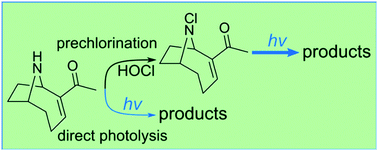Chlorine/UV treatment of anatoxin-a by activation of the secondary amine functional group†
Abstract
Studies of the combined application of chlorine and UVC radiation (Cl/UV) have generally focused on target compound degradation by the combined effects of direct photolysis and reactions with radical intermediates. However, prechlorination also has the potential to impart structural changes on molecules that increase their sensitivity to direct photolysis. Specifically, the prechlorination of amines leads to formation of their N-chlorinated derivatives, which is important because the N–Cl bond is photolabile. The Cl/UV process was examined for degradation of the secondary amines anatoxin-a (ANTX-a) and dimethylamine. ANTX-a and dimethylamine were both shown to undergo rapid N-chlorination. The first-order rate constant for photodecomposition of N-chlorodimethylamine at 254 nm was estimated to be 1.13 ± 0.05 × 10−3 cm2 mJ−1, while dimethylamine does not absorb UV254 radiation. The photodegradation of Cl-ANTX-a was also observed to be faster than direct photolysis of ANTX-a. For comparison, a first-order rate constant for photodegradation of Cl-ANTX-a of 1.86 ± 0.05 × 10−3 cm2 mJ−1 at 254 nm was estimated for N-chlorinated anatoxin-a, as compared 1.19 ± 0.02 × 10−3 cm2 mJ−1 for anatoxin-a. The observed increase in first-order rate of photodegradation illustrated activation of anatoxin-a toward photolysis by prechlorination.



 Please wait while we load your content...
Please wait while we load your content...